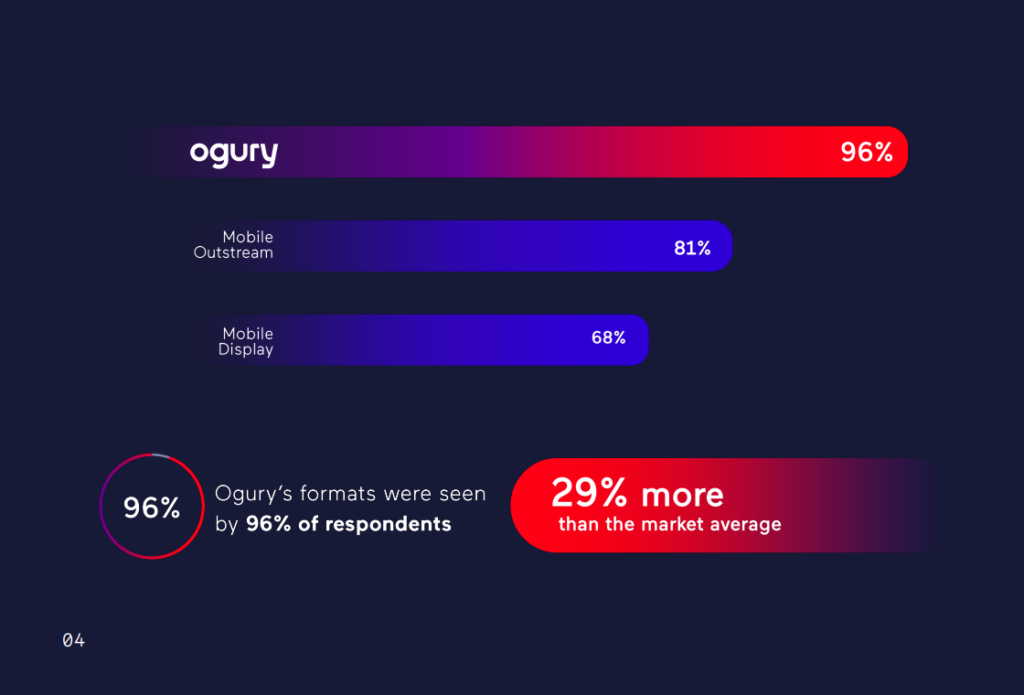The attention misconception
Eight seconds: the average time brands have to make an impression with their advertising. That is also approximately the time it takes to read this opening. It goes by quickly, doesn’t it? Advertising is a tricky business. The average person is exposed to between 6,000 and 10,000 ads a day. That’s a lot of ads. And, unless the person in question has a photographic memory, it’s impossible to retain and respond to that much information.
Modern life is fast-paced and full of considerations. It’s hard enough to remember to pick up milk or your dry cleaning on the way home; recalling all the ads you saw in a day would be unthinkable. But there are always outliers, the ads that demand attention and remain with you long after they end and you move on with your life. In other words, the advertiser’s dream.
The illusion of visibility
Before any flashy, beautiful creatives are designed, the first consideration for any advertiser is the format. You could make a fantastic advertisement with high production value, but if half or less of your creative is visible at any time, where is the return? Picture a billboard obscured by a tree: it could contain a striking advertisement, but what’s the point? A tree is in the way. Now consider the fact that this advertisement is counted as visible according to industry standards. It makes no sense, so why should digital be any different?
As consumers spend an increasing amount of time on their phones, companies have seen the opportunity to advertise their products and services across more areas of the web. The internet has become flooded with advertising over the previous decades, and attention rates have plummeted. It has, therefore, become more critical for companies to ensure their brand messaging doesn’t get lost in the noise.
The first step toward transparency
Most marketers are aware of the limited window to reach their audiences, but how do they know their ad is being seen? Advertising has long relied on outdated and disparate metrics to measure the performance of its campaigns. Advertisers unknowingly rely on an outdated model to measure attention and are wasting their budget on campaigns that are not realizing their full potential. Video Completion Rate (VCR) is one of the predominant metrics used to measure campaign performance. However, this metric does not provide the complete picture and can often deliver inaccurate results.
The MRC counts an ad as seen if half of the creative is viewable for at least one second. However, the problem is that viewable does not equate to viewed. Creatives appearing off-screen or partially visible are wasted ad spend. How can brands be sure their message is clear and understood with such flawed viewability standards?
The first step toward performance transparency is accepting that current metrics do not illustrate the full scope of a campaign. The only video KPI that matters is the Fully On-Screen Rate for 50% duration; this is how we measure performance at Ogury. This metric measures the percentage of impressions where 100% of pixels are viewable for at least half the video duration.
At Ogury, we exclusively utilize 100% on-screen formats that drive superior attention without compromising the user experience. As demonstrated in our study with Lumen, Ogury formats were seen by 96% of participants, 29% more than the market average.

Offer power to the user
However, there is an important distinction between viewability and attention. Ads that have been viewed for longer directly correlate with an increase in recall rate. Unsurprisingly, video ads that utilize fully on-screen formats are viewed for more extended periods. In addition to fully-visible formats, several other considerations are crucial in commanding and retaining attention.
Remember the eight-second rule? Advertisers who go the extra mile to display engaging, punchy, and non-intrusive formats will ultimately dominate the digital advertising market. Not unlike the entertainment industry, it’s all about standing out and delivering content to the right audience at the right time. Campaigns should be backed up by in-depth knowledge of audience insight data.
We have all experienced the frustration of visiting a webpage only to be inundated with a flurry of irrelevant advertising that is neither engaging nor promoting a positive user experience. This only reinforces the negative stereotypes surrounding digital advertising and can cause irreparable damage to a company’s brand. It should be as easy to skip or conceal an advertisement as it is to engage with it. Offering power to the user will ultimately result in a more positive experience and brand association.
‘It should be as easy to skip or conceal an advertisement as it is to engage with it.’
Future formats should be dynamic and respectful of the user
This leads us to the next point of creating advertising experiences that offer choice and interactivity, with emphasis placed on the experience aspect. Formats should provide consumers with the power to choose which advertisement they would like to see. Doing so not only grants more control to the user but inherently requires more attention and will actively promote user engagement.
At Ogury, we are aware of the attention misconception that has plagued the industry for too long. That is why we have taken steps towards creating advertising experiences that promote the highest performance on the market while maintaining full respect for the user experience.
Join a growing network of industry leaders who have foreseen the coming of a new age of digital advertising and get Personified today.
Sharp Adtech Content, In Your Inbox
Subscribe to The Ogury Outlook and get expert insights, industry news, and actionable tips delivered straight to your inbox. Whether you’re looking to strengthen your data strategy or stay informed on industry trends, we’ve got you covered.